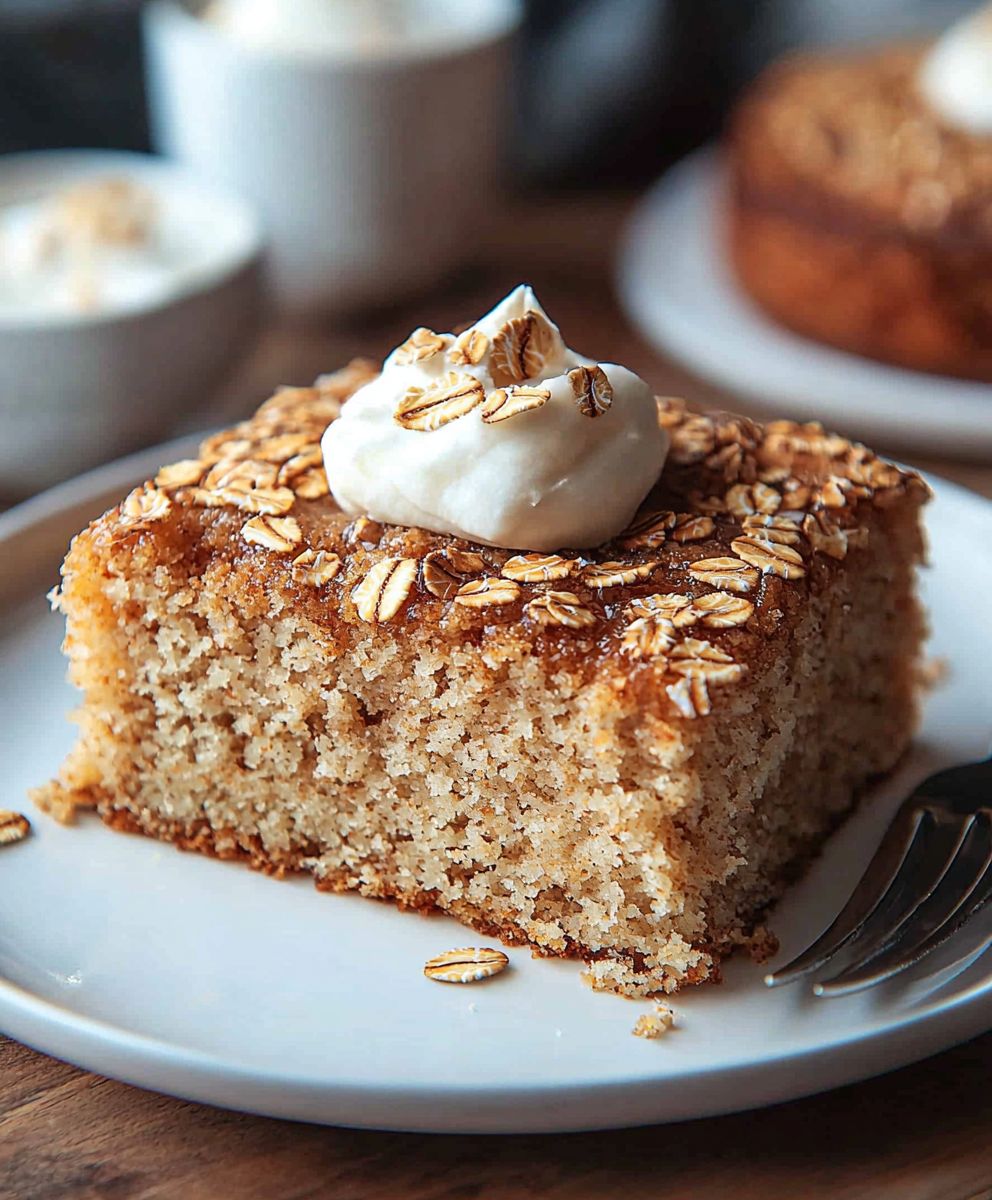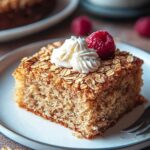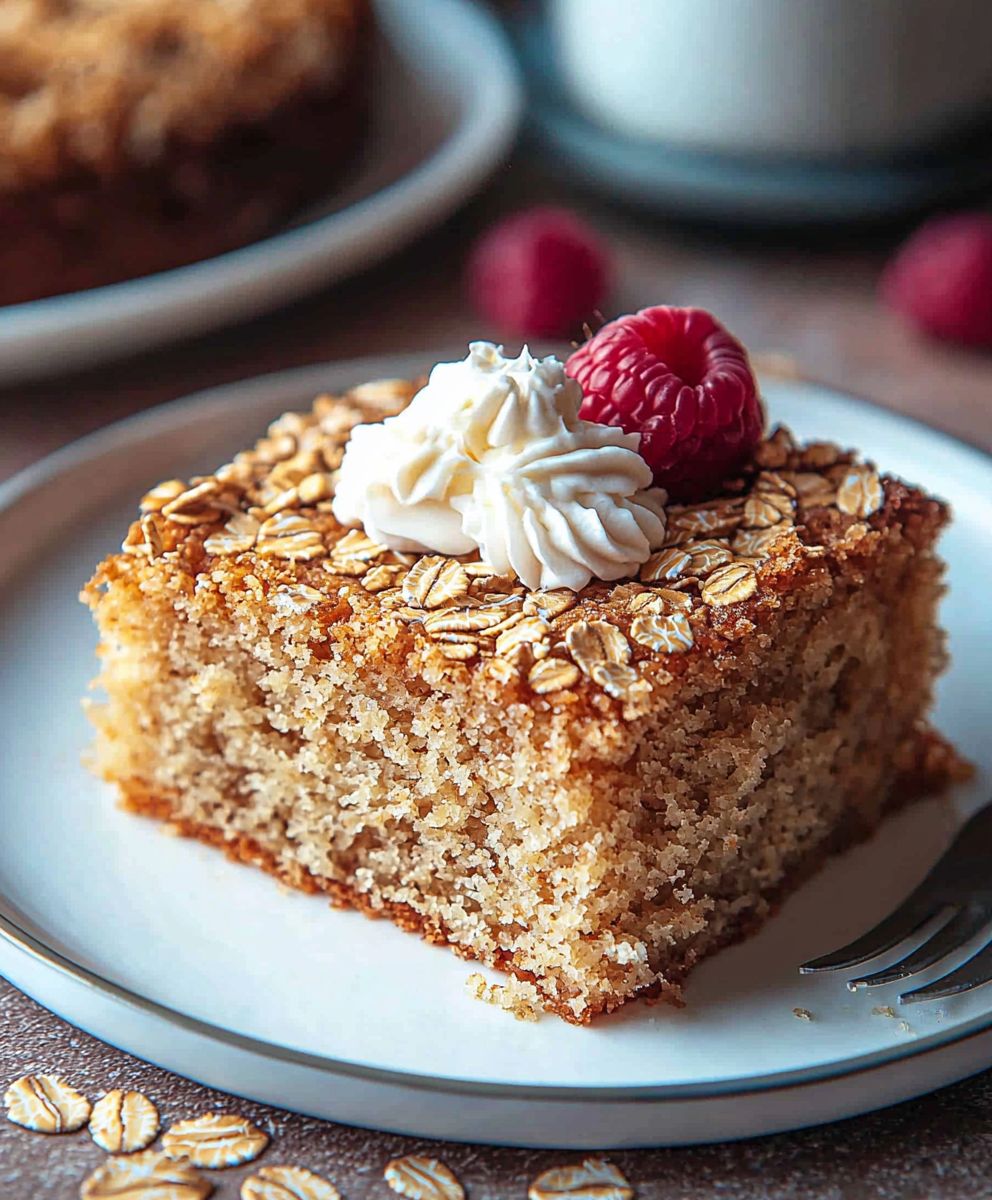Oatmeal Cake: Prepare to be amazed by a dessert that defies expectations! Forget everything you think you know about oatmeal because this isn’t your average breakfast bowl. This is a moist, tender, and surprisingly decadent cake that will have everyone asking for seconds. I stumbled upon this recipe years ago, tucked away in my grandmother’s old cookbook, and it has since become a family favorite, perfect for everything from casual brunches to elegant afternoon teas.
While the exact origins of Oatmeal Cake are a bit hazy, it’s believed to have emerged as a resourceful way to use up leftover cooked oatmeal. During times of scarcity, particularly during the Great Depression, home cooks were masters of making the most of every ingredient. Oatmeal, a readily available and inexpensive grain, found its way into countless dishes, including this delightful cake. It’s a testament to the ingenuity and resourcefulness of generations past.
But beyond its humble beginnings, what makes this cake so irresistible? It’s the unique texture a delightful combination of moistness and a subtle chewiness from the oats. The flavor is comforting and subtly sweet, often enhanced with warm spices like cinnamon and nutmeg. Plus, it’s incredibly easy to make! This Oatmeal Cake is a one-bowl wonder, making it perfect for busy weeknights or when you need a quick and satisfying dessert. Trust me, once you try it, you’ll understand why this unassuming cake has stood the test of time!
Ingredients:
- Dry Ingredients:
- 2 cups all-purpose flour
- 2 cups rolled oats (not instant)
- 1 ½ cups granulated sugar
- 1 teaspoon ground cinnamon
- ½ teaspoon ground nutmeg
- 1 teaspoon baking soda
- ½ teaspoon salt
- Wet Ingredients:
- 1 ½ cups boiling water
- 1 cup (2 sticks) unsalted butter, softened
- 2 large eggs
- 1 teaspoon vanilla extract
- Frosting:
- 6 tablespoons (¾ stick) unsalted butter, softened
- 3 cups powdered sugar
- 3 tablespoons milk
- 1 teaspoon vanilla extract
- ½ cup chopped pecans or walnuts (optional)
Preparing the Oatmeal Mixture:
This first step is crucial for softening the oats and creating a moist, tender cake. Don’t skip it!
- Preheat your oven: Preheat your oven to 350°F (175°C). Grease and flour a 9×13 inch baking pan. This will prevent the cake from sticking and ensure easy removal. I like to use baking spray with flour already in it for extra insurance.
- Combine oats and boiling water: In a large bowl, combine the rolled oats and boiling water. Stir well to ensure all the oats are submerged. Let this mixture sit for about 20 minutes. This allows the oats to soften and absorb the water, which will contribute to the cake’s moist texture. You’ll notice the mixture will thicken slightly as the oats hydrate.
Mixing the Cake Batter:
Now that the oats are softened, we can move on to creating the cake batter. It’s important to follow the order of ingredients to ensure proper mixing and a smooth batter.
- Cream butter and sugar: In a separate large bowl (or the bowl of your stand mixer), cream together the softened butter and granulated sugar until light and fluffy. This usually takes about 3-5 minutes with an electric mixer. Creaming the butter and sugar incorporates air into the mixture, which helps create a light and airy cake. You’ll know it’s ready when the mixture is noticeably lighter in color and has a fluffy texture.
- Add eggs and vanilla: Beat in the eggs one at a time, mixing well after each addition. Then, stir in the vanilla extract. Make sure each egg is fully incorporated before adding the next to prevent the batter from curdling. The vanilla extract enhances the overall flavor of the cake.
- Combine dry ingredients: In a medium bowl, whisk together the flour, cinnamon, nutmeg, baking soda, and salt. Whisking ensures that the dry ingredients are evenly distributed, which is important for consistent baking.
- Gradually add dry ingredients to wet ingredients: Gradually add the dry ingredients to the creamed mixture, alternating with the oat mixture. Begin and end with the dry ingredients. This means you’ll add about a third of the dry ingredients, then half of the oat mixture, then another third of the dry ingredients, then the remaining oat mixture, and finally the last third of the dry ingredients. Mix until just combined. Be careful not to overmix the batter, as this can result in a tough cake. Overmixing develops the gluten in the flour, leading to a dense and chewy texture.
Baking the Cake:
The baking time is crucial for achieving a perfectly cooked cake. Keep an eye on it and use the toothpick test to ensure it’s done.
- Pour batter into prepared pan: Pour the batter into the prepared 9×13 inch baking pan and spread it evenly.
- Bake: Bake in the preheated oven for 30-35 minutes, or until a wooden skewer or toothpick inserted into the center comes out clean. The baking time may vary depending on your oven, so it’s important to check for doneness. The cake should be golden brown on top and spring back lightly when touched.
- Cool completely: Let the cake cool in the pan for 10-15 minutes before inverting it onto a wire rack to cool completely. Cooling the cake completely before frosting prevents the frosting from melting and sliding off.
Making the Frosting:
This frosting is the perfect complement to the oatmeal cake. It’s sweet, creamy, and adds a touch of richness.
- Cream butter: In a large bowl (or the bowl of your stand mixer), cream the softened butter until smooth and creamy. This usually takes about 2-3 minutes with an electric mixer.
- Gradually add powdered sugar: Gradually add the powdered sugar, one cup at a time, beating well after each addition. This prevents the powdered sugar from flying everywhere and ensures a smooth frosting.
- Add milk and vanilla: Add the milk and vanilla extract and beat until the frosting is light and fluffy. If the frosting is too thick, add a little more milk, one tablespoon at a time, until you reach the desired consistency. If the frosting is too thin, add a little more powdered sugar.
- Stir in nuts (optional): If desired, stir in the chopped pecans or walnuts. The nuts add a nice crunch and nutty flavor to the frosting.
Frosting and Serving:
The final step is to frost the cake and enjoy! This cake is delicious served warm or at room temperature.
- Frost the cake: Once the cake is completely cool, frost it with the prepared frosting. Spread the frosting evenly over the top of the cake.
- Serve: Cut the cake into squares and serve. Enjoy! This oatmeal cake is perfect for breakfast, brunch, or dessert. It’s also a great cake to bring to potlucks or gatherings.
Tips for Success:
- Use room temperature ingredients: Using room temperature butter and eggs helps the ingredients emulsify properly, resulting in a smoother batter and a more tender cake.
- Don’t overmix the batter: Overmixing develops the gluten in the flour, leading to a tough cake. Mix until just combined.
- Check for doneness: The baking time may vary depending on your oven, so it’s important to check for doneness. A wooden skewer or toothpick inserted into the center should come out clean.
- Cool completely before frosting: Cooling the cake completely before frosting prevents the frosting from melting and sliding off.
- Store properly: Store leftover cake in an airtight container at room temperature for up to 3 days or in the refrigerator for up to 5 days.
Variations:
- Add fruit: Add ½ cup of raisins, chopped apples, or other dried fruit to the batter for added flavor and texture.
- Use different nuts: Substitute the pecans or walnuts with other nuts, such as almonds, hazelnuts, or macadamia nuts.
- Add chocolate chips: Add ½ cup of chocolate chips to the batter for a chocolatey twist.
- Make it gluten-free: Use a gluten-free flour blend in place of the all-purpose flour.
- Spice it up: Add a pinch of ground cloves or ginger to the batter for a warmer, spicier flavor.
Troubleshooting:
- Cake is dry: Make sure you’re not overbaking the cake. Also, ensure you’re using enough butter and eggs.
- Cake is dense: Avoid overmixing the batter. Also, make sure your baking soda is fresh.
- Frosting is too thick: Add a little more milk, one tablespoon at a time, until you reach the desired consistency.
- Frosting is too thin: Add a little more powdered sugar until you reach the desired consistency.

Conclusion:
This Oatmeal Cake isn’t just another dessert; it’s a warm hug on a plate, a comforting slice of nostalgia, and a surprisingly simple way to impress your friends and family. From its moist, tender crumb to its subtly sweet and nutty flavor, every bite is a delightful experience. I truly believe this recipe deserves a spot in your regular baking rotation. Why is it a must-try? Because it’s incredibly easy to make! Seriously, if you can boil water and stir ingredients together, you can nail this cake. It requires minimal effort and uses ingredients you likely already have in your pantry. Plus, the overnight soaking of the oatmeal creates a unique texture that you won’t find in other cakes. It’s also incredibly versatile. You can easily adapt it to your own tastes and preferences, making it a truly customizable dessert. And let’s not forget the aroma that fills your kitchen as it bakes pure bliss! But the best part? The taste! It’s not overly sweet, making it perfect for those who prefer a more subtle dessert. The oatmeal adds a wonderful depth of flavor and a satisfying chewiness that keeps you coming back for more. It’s the kind of cake that pairs perfectly with a cup of coffee or tea, making it ideal for breakfast, brunch, or an afternoon treat. Now, let’s talk serving suggestions and variations. While this cake is delicious on its own, a simple dusting of powdered sugar elevates it beautifully. For a richer experience, try topping it with a dollop of whipped cream or a scoop of vanilla ice cream. A drizzle of caramel sauce or a sprinkle of chopped nuts would also be fantastic additions. Feeling adventurous? Consider adding some mix-ins to the batter. Chocolate chips, dried cranberries, raisins, or chopped walnuts would all be delicious choices. You could also experiment with different spices, such as cinnamon, nutmeg, or ginger, to create your own unique flavor profile. For a truly decadent treat, try frosting it with a cream cheese frosting or a chocolate ganache. Another variation I love is adding a layer of fruit to the bottom of the pan before baking. Sliced apples, peaches, or berries would all work wonderfully. This adds a burst of freshness and moisture to the cake, making it even more irresistible. You could even use canned fruit in a pinch! I’m confident that you’ll love this Oatmeal Cake as much as I do. It’s a simple, satisfying, and incredibly delicious dessert that’s perfect for any occasion. So, what are you waiting for? Grab your ingredients, preheat your oven, and get baking! I’m so excited for you to try this recipe and experience the joy of baking (and eating!) this wonderful cake. Once you’ve made it, please come back and share your experience in the comments below. I’d love to hear what you think, what variations you tried, and any tips or tricks you discovered along the way. Happy baking! And remember, the best part of baking is sharing your creations with the people you love. Enjoy! Print
Oatmeal Cake: The Ultimate Guide to Baking the Perfect Cake
- Total Time: 60 minutes
- Yield: 12–15 servings 1x
Description
Moist and delicious oatmeal cake topped with a creamy vanilla frosting and optional pecans or walnuts. Perfect for breakfast, brunch, or dessert!
Ingredients
- 2 cups all-purpose flour
- 2 cups rolled oats (not instant)
- 1 ½ cups granulated sugar
- 1 teaspoon ground cinnamon
- ½ teaspoon ground nutmeg
- 1 teaspoon baking soda
- ½ teaspoon salt
- 1 ½ cups boiling water
- 1 cup (2 sticks) unsalted butter, softened
- 2 large eggs
- 1 teaspoon vanilla extract
- 6 tablespoons (¾ stick) unsalted butter, softened
- 3 cups powdered sugar
- 3 tablespoons milk
- 1 teaspoon vanilla extract
- ½ cup chopped pecans or walnuts (optional)
Instructions
- Preheat oven: Preheat oven to 350°F (175°C). Grease and flour a 9×13 inch baking pan.
- Combine oats and boiling water: In a large bowl, combine the rolled oats and boiling water. Stir well and let sit for 20 minutes.
- Cream butter and sugar: In a separate large bowl, cream together the softened butter and granulated sugar until light and fluffy (3-5 minutes).
- Add eggs and vanilla: Beat in the eggs one at a time, mixing well after each addition. Then, stir in the vanilla extract.
- Combine dry ingredients: In a medium bowl, whisk together the flour, cinnamon, nutmeg, baking soda, and salt.
- Gradually add dry ingredients to wet ingredients: Gradually add the dry ingredients to the creamed mixture, alternating with the oat mixture. Begin and end with the dry ingredients. Mix until just combined.
- Pour batter into prepared pan: Pour the batter into the prepared 9×13 inch baking pan and spread it evenly.
- Bake: Bake in the preheated oven for 30-35 minutes, or until a wooden skewer or toothpick inserted into the center comes out clean.
- Cool completely: Let the cake cool in the pan for 10-15 minutes before inverting it onto a wire rack to cool completely.
- Cream butter (frosting): In a large bowl, cream the softened butter until smooth and creamy (2-3 minutes).
- Gradually add powdered sugar (frosting): Gradually add the powdered sugar, one cup at a time, beating well after each addition.
- Add milk and vanilla (frosting): Add the milk and vanilla extract and beat until the frosting is light and fluffy. Adjust milk/powdered sugar for consistency.
- Stir in nuts (optional): If desired, stir in the chopped pecans or walnuts.
- Frost the cake: Once the cake is completely cool, frost it with the prepared frosting.
- Serve: Cut the cake into squares and serve.
Notes
- Use room temperature ingredients for best results.
- Don’t overmix the batter.
- Check for doneness with a toothpick.
- Cool completely before frosting.
- Store leftover cake in an airtight container at room temperature for up to 3 days or in the refrigerator for up to 5 days.
- Variations: Add fruit, use different nuts, add chocolate chips, make it gluten-free, spice it up.
- Troubleshooting: Cake is dry (don’t overbake, use enough butter/eggs), cake is dense (don’t overmix, fresh baking soda), frosting too thick (add milk), frosting too thin (add powdered sugar).
- Prep Time: 25 minutes
- Cook Time: 35 minutes





Leave a Comment